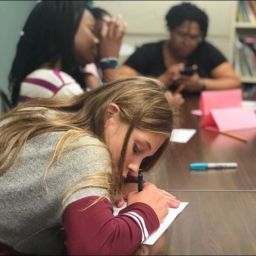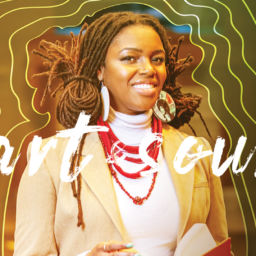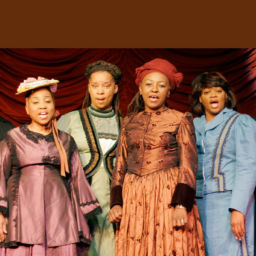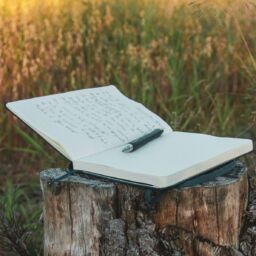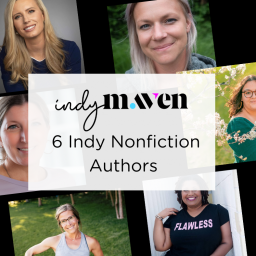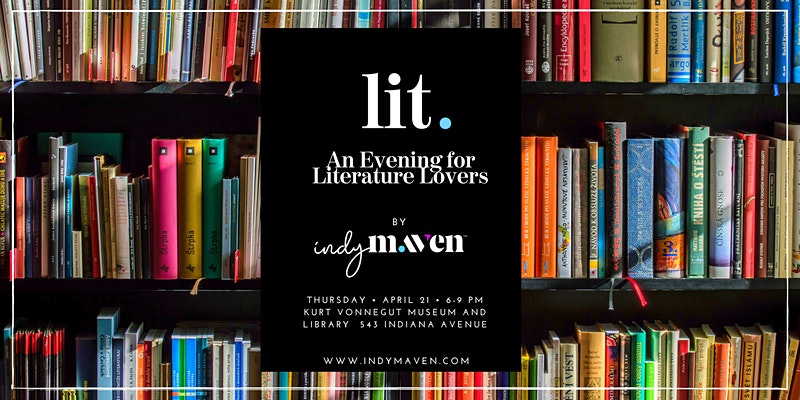
We are so excited to present LIT: A literary-inspired evening on April 21 at the Vonnegut Museum and Library. If you plan to be there (or even if you don’t), here’s a sneak peek at the three talented authors who will be panelists at the event; we hope you’ll get the pleasure to meet them in person. The event will be moderated by Tiffany Lauderdale Phillips, owner of Wild Geese Bookshop in Franklin, Indiana.
MEET BARBARA SHOUP, AUTHOR OF EIGHT NOVELS
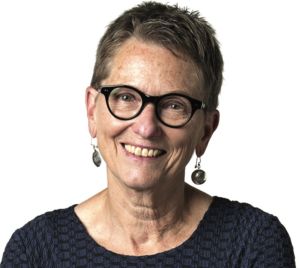
Barbara Shoup wrote her first novel in the fifth grade, a story about the Underground Railroad. After she finished it (all 40 pages!), she sent it off to a publisher in NY whose name she’d found in a library book. Not long after she received a kind rejection, she learned that the Underground Railroad was not the subway she had imagined it to be. She was so mortified it took her twenty years to get up the nerve to try writing again.
Currently, you are the Writer-in-Residence at the Indiana Writers Center (IWC). What does it mean to be “in residence?”
It means that I serve the IWC in a variety of ways, including teaching, developing and working with community partners, and participating in long-range planning with the staff and board of directors. I’ve been involved with the Writers Center since it began in 1979. I passionately love and believe in what we do and a piece my heart will be in-residence there forever.
You taught creative writing to high school students for more than twenty years. What is your biggest pet peeve when it comes to writing?
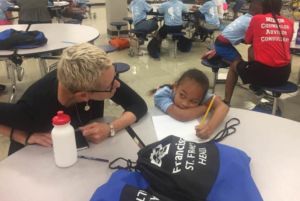
My biggest pet peeve about teaching aspiring writers of any age is the refusal to think of writing as craft and revision as crucial to creating work worth reading. This is related to my pet peeve about parents (and sometimes teachers) who allow kids to believe they’re so talented that the publishing world will receive them with open arms. Writing is a craft which must be learned, regardless of any inborn talent. And talent is considerably more than that inborn “way with words.” It’s also discipline, curiosity, and a deep need to remake the world with words.
That said, I loved teaching high school students and miss having their daily presence in my life.
The best of them pretty quickly figured out that writing was a process and gave themselves to it in a way that taught me at least as much as I taught them.
When do you feel your most creative?
When I’m all by myself in a quiet space with time to settle in and let everything but what I’m working on fall away. I’ve been fortunate to have numerous residencies at Ragdale, two to three weeks with all day to write and the company of a dozen or so writers, painters, dancers, musicians, and other artists at the wonderful meal prepared for us each evening. Sometimes I get away to our little house in northern Michigan for a week or so, just me and my dog. Both feel like heaven! But I can get into that creative space at home, too—in the very early morning when the house is quiet and I’m the only one awake.
Where do you draw the inspiration for your work?
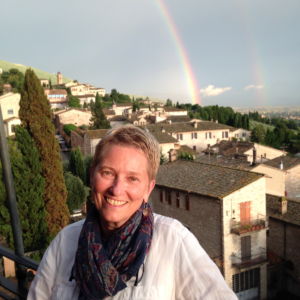
My own life provides a wealth of unanswerable questions to explore in fiction: why did things happen as they did, who might I have been if they hadn’t happened, or had happened differently? In various ways, I’ve leapt into fiction from the moment I met my husband the day I arrived in Bloomington as a freshman, playing out how things might have turned out differently. (I always come out of the story glad our life together turned out exactly as it did.) Right now, I’m looking at my life as a seventh grader during a transitional time for my family by way of fiction and seeing all kinds of things I’ve never seen before.
I’ve gotten inspiration from the lives of others, too—especially some of the high school kids I taught over the years—though the YA books they inspired are also another way of looking at my own difficult adolescence.
And art! I just finished a novel that hinges on a fictional work by the Early Renaissance artist, Piero della Francesca. The rabbit hole of research was delicious!
What advice would you give other women who aspire to be authors?
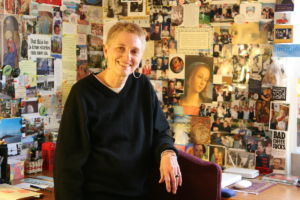
Really, it’s the same advice I give everyone. You’re the only one who knows whether writing is something you need in your life to be who you want to be. If it is, take a deep breath and enter the long process of creating work you can be proud of. This means—among many other things—learning the craft, regarding good criticism as a gift, and figuring out what you can and can’t control in your writing life. There’s no ladder to climb. Wonderful writers get nowhere, terrible writers become millionaires—and then there are those of us in between. Write from the heart. Don’t try to please the market. Be generous to other writers, glad for their success. Learn to love the process more than the outcome. Attend readings, workshops, classes—wherever you might meet writers on your wavelength. Begin to build your own personal writing community. Oh, and join the Indiana Writers Center. You’ll find kindred spirits there.
Other than your much-anticipated appearance at LIT, what can we expect from you in the future?
I’ll be doing a session on novel-writing at the IWC’s Gathering of Writers on Saturday, April 23 at the Indiana State Library—a gorgeous, inspiring venue. It’s always a fabulous day. You should come, too!
I’ll also be doing a Get Started class at the IWC on June 14 & 28 and one on Writing for Young Adults on June 7. Find more information on the classes here.
IWC’s summer learning program “Building a Rainbow” will happen twice weekly at three different Indianapolis sites. Kids write about their lives with the help of our instructors, college interns, and volunteers. If you’d like to volunteer, email me at barbarashoup@indianawriters.org.
I’ll be teaching fiction from July 28-August 11 at Art Workshop International in Assisi, Italy. This is a wonderful, welcoming program for writers of all levels in one of the most beautiful small cities in the universe. Check it out. What you see first would be the view from your window.
MEET CHANTEL MASSEY, POET, AUTHOR, AND TEACHING ARTIST
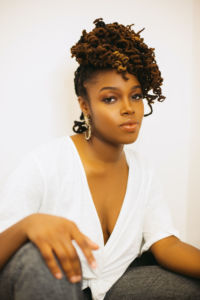
Chantel Massey (she/her) is a poet, author, teaching artist, educator, practicing Afrofuturist, and anime lover based in Indiana. Massey is a fellow of The Watering Hole and has received invitations/support from Hurston/Wright Foundation and Tin House. She is a 2019 Best of Net Award nominee and author of “Bursting at the Seams,”(VK Press, 2018) which was a 2020 Indiana Eugene and Marilyn Glick Author Awards Emerging Author finalist. Massey founded the literary arts organization, UnLearn Arts, cultivating and amplifying the craft and wellness of BIPOC writers.
With confessional honesty, her work explores themes of Blackness, womanhood, memory/archive, and the riot of Black joy. Massey is on a life-long mission to inspire curiosity, celebration, and creativity and challenge how we engage with the world.
You founded the literary arts organization, UnLearn Arts, which is “radically dedicated to amplifying and cultivating the craft and wellness of BIPOC writers in the Midwest and elsewhere.” What drove you to start this organization, and how can others help further its mission?
After writing my first book in 2018, “Bursting at the Seams,” I really wanted to know more about publishing and how to grow in the craft of poetry, both literary and performance.
I couldn’t find anything or anywhere that I felt truly honored my voice and style. So, I turned to books about craft written by BIPOC writers, mostly Black women. There were also a lot of people asking me about my writing and publishing process. This led to creating a workshop—it was intended to be ONE workshop—and I reached out to my friend Elysia at Irvington Vinyl & Books and asked if that could be the space for the workshop. The first one had a really great turnout, so much so that people were asking about when the next one would be.

That one workshop turned into a half year of just trying random themes and seeing what would happen. Then 2020 came and people asked about online workshops. In February, I tried to do an online workshop and it flopped and I was nervous to try, but once the pandemic came, I decided it would be easier for UnLearn Arts to become an entity and it could grow even more and do more with the workshops.
In the last year and a half we have helped over 2,500+ writers and creatives along their journey. The wellness part came in because I was hearing more and more creatives saying they felt pulled away from their creative process because of the pressure to write or create for organizations and it was clear we needed a space to decompress and that honored our wellness, not realizing I had been including this aspect in my workshops anyway because prior to being a full-time writer and teaching artist, I was teaching special education for six years. This background informs so much of what I do—I want to make sure that UnLearn Arts is accessible to others.
The way that people can further this mission is through donations, sharing content, and helping us create more opportunities for Black and brown writers in Indianapolis and the Midwest. Currently, I am a one-woman team, so folks who would like to volunteer or share a passion for this work and would like to get involved can always reach out to help as well.
Just to name a few, you are a recipient of the Arts Council of Indianapolis’ 2022 Beckmann Emerging Artist Fellowship Award, the 2021 Martha’s Vineyard Institute of Creative Writing Poetry & Author Fellowship Award, a Central Indiana Community Foundation (CICF) 2021 Artist Ambassador grant, and the 2020 Indiana Writers Center Mari Evans grant award. Out of all of your accomplishments and accolades, what are you most proud of so far?
I would have to say I am still most proud of just publishing “Bursting at the Seams;” it was a long and tireless process. It was a lot of work emotionally, mentally, and physically. I am very proud of myself for standing in my truth and sharing the beginning of my story.
When do you feel your most creative?
I feel most creative in community—maybe it’s the poet in me, I am not sure, but when I am writing with others, even if we never tell each other what we wrote about or never give each other feedback, I feel most creative in those spaces. I also feel most creative when I’m not intentionally seeking out inspiration.
Where do you draw the inspiration for your work?
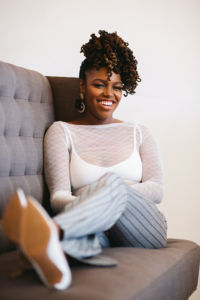
I draw inspiration from almost anything, really. These days I am drawing my inspiration from Indianapolis and the history here, or my family and friends and our shared connection to Indiana, or even Indiana’s connection to the rest of the world. I feel like I want to get to know “her” more.
What advice would you give other women who aspire to be poets or authors?
The advice that I would give aspiring authors and poets—I learned this from Shavonne Holton while working with VKPress—is to know your “why.” Ask yourself why is it that you are writing this book or sharing this poem because some days are harder than others, and that “why” will keep you grounded more than anything else. It’ll help you finish the book or carry you through rejection because that is always tied to the life of a writer and it’ll help you on days when you need to rely on discipline more than your passion.
Other than your much-anticipated appearance at LIT, what can we expect from you in the future?
I am currently working on another collection of poetry right now.
MEET SUSAN NEVILLE, AUTHOR OF SIX WORKS OF CREATIVE NONFICTION
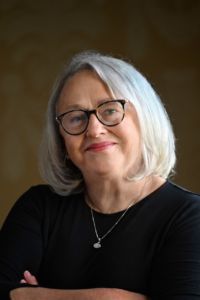
Susan Neville is the author of six works of creative nonfiction: “Fabrication: Essays on Making Things and Making Meaning;” “Twilight in Arcadia;” “Iconography: A Writer’s Meditation;” “Butler’s Big Dance;” “Sailing the Inland Sea,” and “Light.” Her essay on women in the Klan in Indiana, “Into the Fire,” is available as an ebook from Ploughshares.
She’s also the author of three collections of short fiction, and she recently retired from teaching English at Butler, where she was the Demia Butler Professor of English. Susan’s recent story collection is “The Town of Whispering Dolls,” a book that won the Catherine Doctorow Prize for Innovative Fiction.
Can you please explain more about what “creative nonfiction” is?
Creative nonfiction is fact-based writing that uses the techniques of poetry and fiction as well as research to tell a story or explore an idea. It grew out of “the new journalism” and traditions of the essay and the meditation.
I write both creative nonfiction and fiction, but I started writing and publishing in the creative nonfiction genre before it became popular in the United States and was suddenly recognized by critics as something “new.” So, it’s become something of a specialty when I teach.
You have taught writing at Butler University and in the Warren Wilson MFA Program for Writers. Do you mind sharing a tip for something a person can do to improve their writing skills?
Good question! Of course you have to read constantly and begin reading like a writer—paying attention to how other writers accomplish different effects. Really take stories apart and see how they work. Pay particular attention to how dialogue is written in fiction, which is a bit different from how it works in real life. (I could go on and on here, but I won’t!) Write often and pay attention to small details as you go through your life.
When do you feel your most creative?
I feel my most creative in the morning and when I’m in the middle of a project. I can be feeling not creative and then start something reluctantly, but soon the process itself creates a sense of openness and an abundance of ideas that become words.
Stephanie Groves is the Executive Editor of Indy Maven and she is embarrassed to say that it has been way too long since she’s read a book for pleasure.
All of our content—including this article—is completely free. However, we’d love if you would please consider supporting our journalism with an Indy Maven membership.







